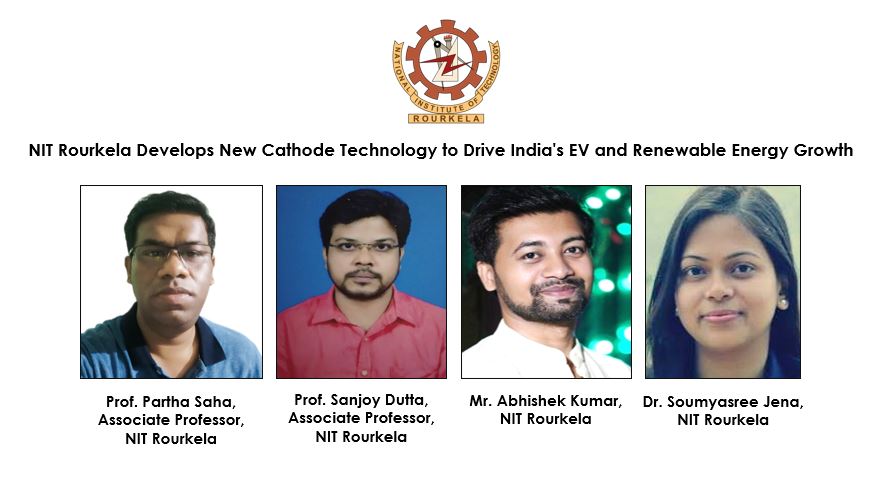Researchers at National Institute of Technology Rourkela (NIT Rourkela) have developed a new class of cathode materials for lithium-ion batteries, presenting a promising alternative to cobalt-based designs. This innovation addresses challenges associated with the high cost, scarcity, and environmental concerns of cobalt, a key component in conventional lithium-ion batteries.
The research team, led by Dr. Partha Saha, Associate Professor, Ceramic Engineering, includes Prof. Sanjoy Datta, Associate Professor, Dr. Soumyasree Jena, Research Graduate, and Mr. Abhishek Kumar, Research Scholar, have created cobalt-free cathode materials using magnesium and nickel. These materials enhance lithium-ion movement, resulting in improved battery performance, greater stability, higher capacity retention, and longer-lasting energy storage.
Lithium-ion batteries, which power devices like smartphones, laptops, and electric vehicles (EVs), predominantly use cobalt-based cathodes. However, cobalt presents several challenges, including its high cost and price volatility, limited availability, with major sources in countries like Cuba, Madagascar, and Papua New Guinea, and significant environmental and ethical concerns associated with its extraction. These issues are becoming increasingly critical as the demand for EVs and lithium-ion batteries continues to grow. Projections indicate that by 2050, the global supply of cobalt may not meet the rising demand, underscoring the urgent need to develop alternative materials.
The research team developed magnesium-based cathode materials as a sustainable and cost-effective alternative to cobalt. Their patented work (Patent No. 554274, Application No. 202431014198) demonstrates that magnesium can effectively replace cobalt in cathode structures without compromising performance.
Magnesium offers several advantages: it is affordable, abundant, and widely available in India, with significant deposits in Tamil Nadu, Uttarakhand, and Karnataka. Additionally, magnesium is environmentally friendly, helping to reduce the ecological impact of battery production.
The cobalt-free cathodes developed by the research team offer several key benefits. Magnesium ions enhance structural stability, effectively addressing issues like ion mixing that often degrade cobalt-based cathodes. This results in improved performance, with the new cathodes retaining 74.3% of their original capacity even after 100 charge-discharge cycles—a significant advancement over traditional designs. Additionally, the use of magnesium reduces production costs, making lithium-ion batteries more affordable and accessible.
Explaining the research, Dr. Partha Saha said, “Our research shows that the new cathode retains 74.3% of its original capacity after 100 charge-discharge cycles, a significant improvement over the rapid capacity loss observed in traditional cobalt-based cathodes. Additionally, the new cathode minimizes the cationic disorder of nickel in lithium sites—a common issue in traditional NMC-based cathodes that leads to capacity and voltage fade.”
This breakthrough has wide-ranging implications and applications. It paves the way to produce affordable, high-performance batteries for electric vehicles, contributing significantly to the growing EV industry. Additionally, it supports India’s renewable energy goals by enabling cost-effective energy storage solutions essential for sustainable development. By reducing dependency on imported materials, this innovation also enhances India’s self-reliance in battery production, strengthening the country’s position in the global energy market.
This research was funded by the Department of Science and Technology’s Nanomission program and conducted in collaboration with the Department of Physics and Astronomy at NIT Rourkela.
NIT Rourkela’s pioneering work in developing cobalt-free cathodes is a significant step toward creating sustainable, affordable, and high-performance lithium-ion batteries. This innovation will not only benefit industries and consumers but also support India’s vision of a cleaner and more energy-efficient future. The research significantly aligns with the Government of India’s Electric Vehicle (EV) Mission, which promotes research and development for EV adoption in India and focuses on the indigenization of battery technologies under the “Make in India” and “Atmanirbhar Bharat” initiatives, reinforcing the country’s push toward self-reliance and sustainability in the EV sector.

